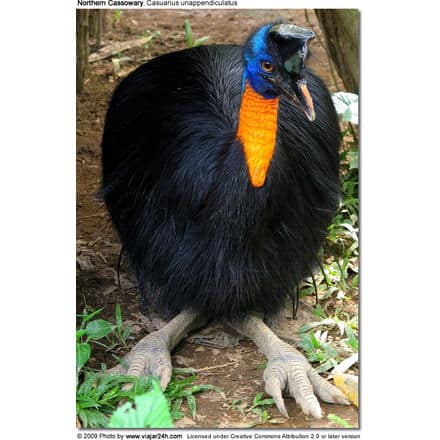Icterids
The Icterids are a group of small to medium, often colorful New World. Most species have black as a predominant plumage colour, often enlivened by yellow, orange or red. The name, meaning “jaundiced ones” (from the prominent yellow feathers of many species) comes from the Ancient Greek ikteros, through the Latin ictericus.
This group includes such popular forms as the New World blackbirds, New World orioles, the Bobolink, meadowlarks, grackles, cowbirds, oropendolas and caciques.
Despite the similar names, the first groups are not related to the Old World Blackbird (a thrush, Turdidae), or the Old World orioles (Oriolidae).
Systematics
FAMILY ICTERIDAE
- Genus Dolichonyx – Bobolink
- Genus Agelaius – Typical American blackbirds (11 species)
- Genus Nesopsar – Jamaican Blackbird : Endemic to Jamaica. They inhabit subtropical or tropical moist lowland forests and moist montanes. The continued existence of this species is threatened by habitat destruction.
- Genus Sturnella – meadowlarks (7 species)
- Genus Xanthocephalus – Yellow-headed Blackbird
- Genus Dives -The three species look similar, with plumage ranging from brownish black in juveniles to black with iridescence (green, blue, or violet) in adults, slightly more iridescent in males. The bare parts are black and the eyes are dark brown. The upper edge of the bill (the culmen) is curved, not flattened as in many other icterids, and the bill has a slight hook at the tip. The songs are varied and pleasant. If the ranges of the Melodious Blackbird and the northern populations of the Scrub Blackbird overlapped, they would be indistinguishable in the field apart from voice, and some authorities lump these two species into one; on the other hand some split the Scrub Blackbird into two species. All three live in open habitats, including agricultural land, and have adapted well to human disturbance. This genus is believed to be most closely related to Euphagus and Quiscalus. It contains three species:
- Cuban Blackbird, Dives atroviolacea : Endemic to Cuba. Its natural habitats are subtropical or tropical moist lowland forests and heavily degraded former forest.Melodious Blackbird, Dives dives : The Melodious Blackbird lives in Mexico and Central America; the Scrub Blackbird in Ecuador and Peru.Scrub Blackbird, Dives warszewiczi: Found in Ecuador and Peru. Its natural habitats are subtropical or tropical moist lowland forests and heavily degraded former forest.
Both species are migratory, wintering in the southern United States and Mexico, although some Brewer’s Blackbirds are present all year in the western USA. A prehistoric relative, Euphagus magnirostris, is known from Late Pleistocene fossils found in the famous tar seeps of Rancho La Brea, California.
The living species are very similar medium-sized birds. Adult males have mainly black plumage and a bright yellow eye; the females are dark grey-brown. They build cup nests, and the female alone incubates the eggs. They are gregarious outside the breeding season.
Both species feed on seeds and insects, the Rusty having a particularly high insect component to its diet. The fortunes of the two species are contrasting, with Brewer’s expanding east in the Great Lakes region, whilst Rusty shows a worrying decline in numbers.
- Genus Euphagus (2 species): Contains two North American species,
- the Brewer’s Blackbird, Euphagus cyanocephalus, and the Rusty Blackbird E. carolinus.
- Genus Quiscalus – true grackles (5 living species, 1 recently extinct)
- Genus Agelaioides – Bay-winged Cowbird (formerly in Molothrus) : Found in Argentina, Bolivia, Brazil, Chile, Paraguay, and Uruguay. Its natural habitats are pastureland and heavily degraded former forest.
- Genus Molothrus – true cowbirds (5 species, includes Scaphidura)
- Genus Icterus – New World orioles (25-30 species)
- Genus Amblycercus – Yellow-billed Cacique
- Genus Ocyalus– Band-tailed Oropendola (might include Clypicterus)
- Genus Clypicterus – Casqued Oropendola
- Genus Cacicus – true caciques (10 species)
- Genus Psarocolius – true oropendolas (about 10 species, includes Gymnostinops)
- Genus Gymnomystax – Oriole Blackbird
Genus Pseudoleistes – marshbirds (2 species)- Yellow-rumped Marshbird, Pseudoleistes guirahuro : Found in Argentina, Brazil, Paraguay, and Uruguay. Its natural habitats are dry savanna, swamps, and pastureland.Brown-and-yellow Marshbird, Pseudoleistes virescens: Found in Argentina, Brazil, Paraguay, and Uruguay. Its natural habitats are swamps and pastureland.
- Genus Amblyramphus – Scarlet-headed Blackbird
- Genus Hypopyrrhus – Red-bellied Grackle : The Red-bellied Grackle is monotypic (one single species) within the genus Hypopyrrhus. It is endemic to Colombia. This bird species inhabits subtropical or tropical moist montane forests. The continued existence of this species is threatened by habitat destruction.
- Genus Curaeus (2 species)
- Austral Blackbird (Curaeus curaeus): Found in Argentina and Chile. Its natural habitats are temperate forests, subtropical or tropical high-altitude shrubland, and heavily degraded former forest.Forbes’s Blackbird (Curaeus forbesi): It is endemic to Brazil. Its natural habitats are subtropical or tropical moist lowland forests, subtropical or tropical seasonally wet or flooded lowland grassland, and plantations . The continued existence of this species is threatened by habitat destruction.
- Genus Gnorimopsar – Chopi Blackbird : The Chopi Blackbird is monotypic (one single species) within the genus Gnorimopsar. It is found in Argentina, Bolivia, Brazil, Paraguay, Peru, and Uruguay. Its natural habitats are dry savanna, subtropical or tropical seasonally wet or flooded lowland grassland, pastureland, and heavily degraded former forest.
- Genus Oreopsar – Bolivian Blackbird: The Bolivian Blackbird s monotypic (one single species) within the genus Oreopsar. It is endemic to Bolivia. Its natural habitats are subtropical or tropical high-altitude shrubland and pastureland.
- Genus Lampropsar – Velvet-fronted Grackle: The Velvet-fronted Grackle is monotypic (one single species) within the genus Lampropsar. It is found in Bolivia, Brazil, Colombia, Ecuador, Guyana, Peru, and Venezuela. Its natural habitats are subtropical or tropical swamps and heavily degraded former forest.
- Genus Macroagelaius (2 species)
- Golden-tufted Grackle (Macroagelaius imthurni): Found in Brazil, Guyana, and Venezuela. This bird species inhabits subtropical or tropical moist montanesMountain Grackle (Macroagelaius subalaris) : It is endemic to Colombia. This bird species inhabits subtropical or tropical moist montane forests. It is threatened by habitat loss and declining in numbers. It was uplisted from Near Threatened to Critically Endangered status in 2000, due to fears of a collapse of the presumably tiny population. As the species, while still severely declining, has turned out to be more widespread than believed, it is downlisted to Endangered in the 2007 IUCN Red List.[1]
Prehistoric icterid genera that have been described from Pleistocene fossil remains are Pandanaris from Rancho La Brea and Pyelorhamphus from Shelter Cave.





Hi Gordon, thanks for the very detailed information! I am writing a scientific report on the Icterids, and I am wondering what is the reason for all of them living in open habitat or degraded forests? Is this a result of foraging behaviour or unique adaptation to urbanisation? What is your opinion on this? As I can’t find many sources explaining this…